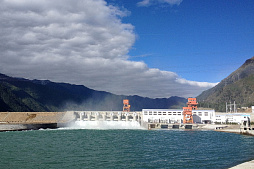After receiving the necessary documents and project presentation, our team will try to review your request as soon as possible, and leading experts will offer the best options for project funding.
As a catalyst for growth, we specialize in facilitating the infusion of long-term capital into your ambitious projects, ensuring sustained success in the Canadian business arena. Our commitment goes beyond financial assistance; we can become your reliable partner, navigating the market to secure the resources essential for business expansion.
Canada's business landscape is teeming with opportunities, and GCAM Investment Group is here to guide you through the process of securing the funding needed for large-scale projects. Whether you're looking to venture into real estate, manufacturing, biotechnology, or any other sector, our investment loans are crafted to meet the unique demands of particular business.
Understanding the Canadian business environment
Canada's economy appears relatively stable and strong after the global geopolitical upheaval that began in 2022, especially compared to Europe's leading economies.Despite some slowdown in 2023, most financial institutions and experts expect Canada's real GDP growth in 2024-2027 to be 2-2.5% annually with projected inflation of less than 2% and unemployment rate not exceeding 6%.
International trade agreements, notably USMCA, shape economic relations. Steady GDP growth, innovative focus, and government policies contribute to economic stability. Immigration is crucial demographically, as Canada attracts millions of active young people from all over the world.
Canada boasts a robust and diverse economy, making it an attractive landscape for businesses seeking growth and opportunities. A wide range of financial options, including the high availability of large investment loans in Canada, along with other advantages, contribute to business development and increased interest in this country from foreign companies.
The benefits of the Canadian economy for large businesses include the following:
• Stability and sound financial system: Canada is known for its stable and resilient economy. The country weathered the global financial crisis relatively well, and its sound financial system, prudent banking practices, and low inflation contribute to a stable economic environment.
• Global trade agreements: Canada has an extensive network of international trade agreements, including the United States-Mexico-Canada Agreement (USMCA) and the Comprehensive Economic and Trade Agreement (CETA) with the European Union. These agreements provide businesses with preferential access to a wide range of global markets, facilitating international trade.
• Access to skilled workforce: Canada boasts a highly educated and skilled workforce. Large businesses can tap into a diverse talent pool, with many workers possessing advanced skills in areas such as technology, engineering, finance, and healthcare.
• Innovation and research opportunities: Canada encourages innovation through research and development initiatives. Various government programs and tax incentives support businesses engaged in cutting-edge research and technology, fostering an environment conducive to innovation.
• Resource abundance: Canada is rich in natural resources, including minerals, oil, and timber. Industries such as mining, energy, and forestry benefit from the abundance of these resources, providing opportunities for large businesses involved in extraction, processing, and export.
• Political stability and rule of law: Canada is known for its political stability, transparent governance, and respect for the rule of law. This stable political environment reduces risks for businesses and fosters an atmosphere conducive to long-term investments.
• Quality of life and social stability: Canada consistently ranks high in global quality of life indices. A stable social environment, excellent healthcare, and diverse cultural amenities make Canada an attractive destination for skilled professionals, enhancing a company's ability to attract and retain top talent.
• Green and sustainable business practices: With an increasing emphasis on environmental sustainability, businesses in Canada are encouraged to adopt green practices. This aligns with global trends and consumer preferences, providing a competitive advantage for companies committed to environmental responsibility.
• Access to capital markets: Canada has well-developed and sophisticated capital markets. Large businesses can access a variety of financial options, including equity / debt markets, facilitating capital raising for expansion, mergers, acquisitions, and other initiatives.
• Government support programs: Various government support programs, grants, and incentives exist at federal, provincial, and municipal levels. These programs aim to stimulate economic development, promote innovation, and support large businesses in different areas.
These factors collectively contribute to Canada's appeal for large businesses, creating an environment conducive to growth, innovation, and sustained success.
Structure of economy and current industry trends
The Canadian economy is diversified, anchored by a rich resource sector, including mining and energy.Notably, Canada is a global energy player. The energy industry, particularly Alberta's oil sands, plays a significant role in economic growth. Oil, gas and other energy products have traditionally occupied a prominent place in Canadian exports.
Canada stands as one of the globe's major players in international trade, boasting a profoundly globalized economy.
In the year 2021, the value of Canadian trade in both goods and services amounted to $2.01 trillion. Notably, Canada's exports surpassed $637 billion, and its imports, valued at over $630 billion, saw a significant portion of $390 billion originating from the USA.
Examining the Canadian economy's sectoral composition in 2020 reveals distinct contributions to the GDP. Real estate and rental emerged as the leading industry, constituting 13%, followed by manufacturing at 10.4%. Other large sectors included mining, quarrying, and oil and gas extraction at 8.2%, finance and insurance at 7%, construction at 7.1%, health care and social assistance at 6.6%, public administration at 6.3%, wholesale trade at 5.8%, and retail trade at 5.6%. This high diversity underscores the dynamic nature of Canada's economic landscape.
The services sector, particularly finance, is highly developed (Toronto's financial hub houses major banks). Manufacturing and technology, including aerospace and telecommunications, have evolved, contributing notably to GDP. Canada is also a leading agricultural exporter.
To make informed decisions about investment, businesses need to stay attuned to industry trends. Below we will analyze key trends in the Canadian business terrain, pinpointing sectors with notable growth potential. You can contact our team for a detailed analysis.
Sectors of the Canadian economy with the greatest investment potential:
• Technology and innovation: The technology sector in Canada is experiencing growth, driven by innovation hubs in cities like Toronto and Vancouver. Investments in artificial intelligence, cybersecurity, and clean technology are particularly promising.
• Renewable energy and sustainability: With a global focus on sustainability, the RES sector in Canada is thriving. Government incentives and a commitment to environmental responsibility make this a key area for potential growth.
• Healthcare and biotechnology: The ongoing emphasis on healthcare and biotechnology is evident, especially given recent global challenges. Canadian companies in these sectors are well-positioned for growth and investment.
• E-commerce and digital services: The shift towards digital services and e-commerce continues to reshape the business landscape. Companies involved in online retail, digital marketing, and related services are capitalizing on changing consumer behavior.
• Natural resources and sustainable practices: Canada's abundance of natural resources, coupled with an increasing focus on sustainable practices, presents opportunities in sectors such as forestry, mining / processing minerals, and innovative agriculture.
Understanding this environment is crucial for companies aiming to leverage emerging opportunities. With a stable economy, government support for business, and a diverse range of growth-oriented industries, Canada provides a fertile ground for businesses seeking expansion.
Canadian banks offering investment loans
Canada's banking sector is robust and well-regulated, with a handful of major banks dominating the landscape.These banks play a crucial role in providing investment loans to businesses across the country. The "Big Five" Canadian banks — Royal Bank of Canada, Toronto-Dominion Bank, Bank of Nova Scotia, Bank of Montreal, and Canadian Imperial Bank of Commerce (CIBC) — are key players in this arena. These banks hold a substantial share of the country's financial assets and are renowned for their stability and sound financial practices. They offer a diverse range of investment loan products, supporting businesses in various sectors with tailored financing solutions.
The largest Canadian banks in providing investment loans for businesses are described below.
Royal Bank of Canada (RBC)
RBC is one of the largest banks in Canada and offers a range of business lending solutions, including long-term investment loans, lines of credit, and commercial mortgages. They cater to businesses of various sizes and industries, such as renewable energy, mining or infrastructure.Listed on the Canadian S&P/TSX 60 stock index and trading on the Toronto Stock Exchange, Royal Bank of Canada serves more than 20 million clients and employs around 94,000 people. The bank's legal headquarters are situated in Montreal, while its operational center is based in Toronto. Forbes ranks the Royal Bank of Canada 50th among the world's 2000 largest companies (2013).
Established in 1864 as the Merchants Bank in Halifax, RBC originated from the aspirations of merchants in Halifax to advance the fish and timber industries and trade with Europe. In 1901 successful bank adopted its current name, and in 1907 the headquarters relocated to Montreal.
Over its history, RBC underwent mergers with many banks, including Royal Trust (1993) and Dexia (2006). As part of the RBC Financial Group, Royal Bank of Canada encompasses RBC Royal Bank, RBC Centura, RBC Capital Markets, RBC Investor & Treasury Services, and RBC Insurance.
The bank's financial products today include long-term investment loans for the development of large projects, including those based on project finance schemes. This is one of the first financial institutions that a large company can turn to to obtain funds for a capital-intensive project.
Toronto-Dominion Bank (TD Bank)
TD Bank provides business loans and lines of credit to support different business needs such as expansion, equipment purchase, and working capital. They also offer specialized lending solutions for different sectors, including heavy industry, commercial real estate, mining, and others.The Toronto-Dominion Bank is headquartered in Toronto and listed on the S&P/TSX 60 stock index. Specializing in financial services, TD Bnak is the second largest financial institution in Canada. Formed in 1955 through the merger of the Bank of Toronto and the Dominion Bank, TD is currently an international financial giant with the center in Toronto's Financial District. Since 2019, TD has been recognized by the Financial Stability Board as a globally systemically important bank, subjecting it to heightened scrutiny and stricter capital requirements.
The bank originated in 1855 when large entrepreneurs of Western Canada (now Ontario) aimed to establish an institution providing specific financial services. By 1856, the Bank of Toronto opened its first branch, initiating the expansion of its network in the province of Ontario. TD Bank underwent several transformations, including the acquisition of Bank Canada Trust in 2000, subsequently operating its retail and commercial banking under the brand TD Canada Trust.
TD Bank Financial Group comprises various business segments, including TD Asset Management, TD Bank, N.A., TD Canada Trust, TD Commercial Banking, TD Insurance, TD Securities, and TD Waterhouse. TD Securities, the investment banking arm, trades fixed-income and equity products, currencies, commodities, and derivatives globally. With a significant presence in North America, Europe, and Asia, TD Securities is recognized as a leading investment provider. TD Waterhouse focuses on investment and private banking, while Symcor, a joint venture with the Royal Bank of Canada and the Bank of Montreal, engages in billing and accounting services.
The bank's rich history and diverse range of services contribute to its prominent position within modern Canada's financial terrain. Recommended for financing large business projects.
Bank of Nova Scotia (Scotiabank)
Scotiabank offers a suite of business loans, including investment loans and revolving credit, to help large businesses meet their financial goals. They provide financial solutions for both domestic and international companies in various areas, from real estate to innovative industrial projects.Scotiabank, also known as Banque Scotia in French, is the Canada's third-largest financial institution. Listed on the Canadian S&P/TSX 60 stock index and traded on the Toronto Stock Exchange, Scotiabank boasts over 950 branches in Canada and a presence in more than 45 countries through 2000 branches. Its headquarters are located in Toronto and, according to the current Forbes' list of the world's 2000 largest companies, the Bank of Nova Scotia holds the 89th position (2022).
Founded in 1832 in Halifax, Nova Scotia, the Bank of Nova Scotia initially focused on the Atlantic provinces, with its first branch opening in Windsor. It wasn't until 1882 that the bank expanded westward with a branch in Winnipeg, Manitoba. Although this branch was later closed, it encouraged further expansion into the Midwest of the United States.
Throughout its history, Scotiabank has engaged in mergers with other Canadian banks, including Montreal Trust (1994), National Trust (1997), Mocatta Bullion and Base Metals (1997), National Bank of Greece (Canada) (2005), Banco Wiesse Sudameris (Peru) (2007), Banco Sudamericano (Peru) (2007), and Banco Colpatria (Colombia) (2012).
Scotiabank's large business segments include Domestic Banking, Scotia Capital Inc., International Banking, e-Commerce/e-Banking at Scotiabank, and Scotiabank Peru S.A.A. The bank's diversified operations span across various sectors, both domestically and internationally.

Bank of Montreal (BMO)
BMO provides investment loans and lines of credit tailored to the specific needs of clients. Their offerings include financing options for real estate, equipment, and general business expansion. The bank occupies 117th position in the Forbes ranking of the world's largest companies (2022).The Bank of Montreal, or Banque de Montréal in French, stands as Canada's fourth-largest bank, officially headquartered in Montreal but with operational headquarters in Toronto since 1977. Listed on the S&P/TSX 60, it's traded on the Toronto Stock Exchange and the New York Stock Exchange. It is a very large, highly diversified financial institution with total assets exceeding $800 billion and employing more than 55,000 employees around the world.
Established in 1817, the Bank of Montreal is Canada's oldest bank, now operating under the name BMO Financial Group. Throughout its history, the Bank of Montreal has undergone mergers with other Canadian banks, including Bank of British North America (1918) and Merchants Bank of Canada (1922). Its services are currently provided under the banner of BMO Bank of Montreal.
BMO Bank operates under the broader BMO Financial Group, which includes divisions such as BMO Harris for U.S. operations, BMO InvestorLine, BMO Life, and BMO Nesbitt Burns.
Canadian Imperial Bank of Commerce (CIBC)
CIBC offers different business financial products, including lines of credit, and commercial mortgages. They work with businesses across different sectors to provide customized financing solutions. Their services encompass project finance and long-term investment loans.The Canadian Imperial Bank of Commerce is one of Canada's largest banks. It is headquartered in Commerce Court in Toronto and extends its presence not only across Canada but also in the United States of America, the Caribbean, Asia, and the United Kingdom.
With over 1,000 branches in Canada, the bank's stock is traded on both the Toronto and New York Stock Exchanges. In 2022, it ranked 189th in the Forbes ranking of the world's largest companies.
Formed in 1961 through the merger of the Canadian Bank of Commerce (established in 1867) and the Imperial Bank of Canada (founded in 1875), CIBC quickly became one of the most successful financial institutions of Northern America. CIBC made history as the first Canadian bank to introduce ATMs for its services in 1969.
In the late 1990s, there were intentions to merge with the Toronto-Dominion Bank, but the Canadian government, led by then-Finance Minister Paul Martin, intervened, blocking the merger. Throughout its history, CIBC has engaged in mergers with other financial institutions, including Wood Gundy Inc. (1988), TAL Private Management (1994), and Penfund (1998).
CIBC's business segments currently include CIBC Retail Markets, CIBC Securities, CIBC World Markets, CIBC Imperial Service, and CIBC Wood Gundy.
Apart from this, it is also worth mentioning the National Bank of Canada, which offers a wide range of financial opportunities for businesses. National Bank provides large investment loans and lines of credit to support clients in their growth initiatives. They offer customized financing solutions for equipment purchases, working capital, and commercial real estate.
Additionally, alternative lenders and credit unions also play a role in providing business financing in Canada. Business owners are encouraged to contact our financial team, compare available offerings, and carefully review the terms and conditions before selecting the most suitable option for their investment loan needs.
Obtaining large investment loan in Canada
In modern Canadian business environment, establishing robust relationships with banks and other financial institutions is crucial for businesses seeking funding.This involves understanding several key elements, from credit history importance to effective negotiation strategies, fostering successful collaborations in this dynamic economic context.
Understanding the significance of a positive credit history is paramount, as Canadian financial institutions heavily rely on credit reports when evaluating loan applications. Moreover, the Canadian banking sector is well-regulated, with major banks dominating the sector.
Crafting a comprehensive business plan is a top priority when seeking financing for large projects in Canada. It serves as a roadmap, outlining your project's vision, strategy, and financial viability. Lenders and investors rely on this blueprint to assess risk and potential returns, making compelling business plan instrumental in securing the necessary funding. Beyond a mere document, it is a strategic tool that demonstrates your commitment, foresight, and the well-calculated approach necessary for the success in the Canadian business terrain.
It's also important to grasp the unique offerings and regional focuses of each financial institution. Canada is a very diverse country, where each province has certain, sometimes significant differences from its neighbors. Understanding regional dynamics and the importance of local banking relationships can offer strategic advantages.
Factors such as economic conditions, industry specialization, and local government policies can vary between provinces. Some provinces may offer specific incentives for certain industries, influencing the attractiveness for investors.
For example, resource-rich provinces like Alberta or Saskatchewan might have different investment patterns compared to provinces with a strong tech sector, such as Ontario or British Columbia.
Additionally, regional stability, infrastructure development, and the regulatory environment can impact the ease of attracting investment.
Strong negotiation strategies are essential when seeking favorable loan terms. Exploring numerous government-backed programs and incentives in Canada can provide valuable avenues for securing financing with favorable conditions. Demonstrating proactive risk management, regularly assessing your business's financial health, and maintaining transparent communication are also important elements that enhance credibility with financial institutions.
Table: Building effective relationships to obtain investment loan in Canada
| Recommendations | Brief description and considerations |
| Credit history significance | A positive credit history is crucial for investment loan approval in Canada. Financial institutions assess your creditworthiness based on this history. Regularly monitoring and maintaining a favorable credit report enhances your chances of securing loans. |
| Understanding banking sector | Canada has a well-regulated banking sector. Understanding the nuances of each bank or credit union, their services, and regional focus helps tailor your approach when seeking financial partnerships. |
| Negotiation strategies for favorable terms | Effective negotiation is essential. Articulate your business's financial health, growth plans, and how the loan aligns with your objectives. |
| Government programs and incentives | Canada offers government-backed programs and incentives to support businesses. Leveraging these initiatives can provide additional avenues for securing financing with favorable terms. |
| Risk management and mitigation | Major financial institutions in Canada prioritize businesses that demonstrate effective risk management. Understand and mitigate potential risks associated with your industry or business model to enhance your credibility. |
| Regional dynamics and local banking relationships | Consider regional dynamics and the importance of local banking relationships. In Canada, businesses often benefit from establishing connections with local branches of major financial institutions. |
| Legal and regulatory adherence | Ensure your business adheres to all legal requirements. Compliance with laws and regulations is paramount for financial institutions, showcasing your commitment to ethical business practices. |
| Industry-specific considerations | Recognize industry-specific considerations. Different sectors may have varying financing needs and risk profiles. Tailor your approach to align with the expectations and dynamics of your specific industry. |
Attracting long-term capital in Canada involves considering various financing options.
Traditional bank loans offer stability and competitive interest rates but often require a strong credit history and collateral. Government-backed loans, like those from the Business Development Bank of Canada (BDC) or Export Development Canada (EDC), provide additional support, with much more flexible terms and lower interest rates for eligible businesses.
Loan issued by private investors, another avenue, offer tailored solutions with potentially faster approval processes. However, interest rates can be higher, reflecting the increased risk.
Each loan type has specific eligibility criteria, interest rate structures, and repayment terms.
A thorough analysis of these factors is essential in aligning the financing strategy with the unique needs of your business project in Canada.
Exploring modern Canadian financial terrain involves understanding the unique aspects of the country's banking sector, considering regional variations, and aligning business strategy with the expectations of financial institutions to foster successful partnerships.
GCAM Investment Group, thanks to extensive business contacts around the world, is ready to help you implement capital-intensive business projects, including by attracting a long-term investment loan in Canada and other countries of the world on favorable terms.




























